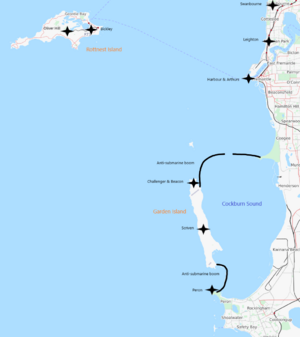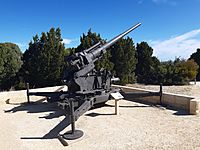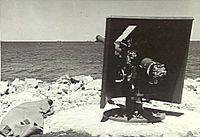Fremantle Fortress facts for kids
Quick facts for kids Fremantle Fortress |
|
|---|---|
| Fremantle, Western Australia in Australia | |
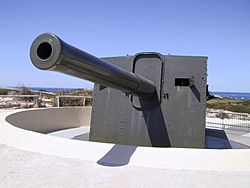
A 9.2-inch naval gun of the Oliver Hill Battery, Rottnest Island
|
|
| Coordinates | 32°03′S 115°44′E / 32.050°S 115.733°E |
| Site information | |
| Owner | Minister for Defence |
| Operator | Australian Army |
| Site history | |
| Built | 1930s |
| In use | 1938−1963 |
| Events | World War II |
Fremantle Fortress was a strong system of coastal defenses built to protect Fremantle Harbour in Western Australia. These defenses were mostly used during World War II. The fortress stretched along the coast of Perth, from Cape Peron to Swanbourne. It also included important military sites on Garden Island and Rottnest Island.
Even though some defenses were set up as early as 1906, the main fortress was built in the 1930s. It was taken apart by 1963. During World War II, Fremantle Harbour was a very important submarine base. It was the second most important Allied submarine base in the Pacific War, after Pearl Harbor.
Soldiers from the Royal Australian Artillery, Royal Australian Engineers, and the Volunteer Defence Corps operated the coastal batteries. Women from the Australian Women's Army Service also served at the Fremantle Fortress.
Today, some parts of the fortress are still around. The Oliver Hill Battery and its railway on Rottnest Island are popular tourist spots. Parts of the Leighton Battery at Buckland Hill have been fixed up, and you can visit its underground tunnels. A bunker and a gun mount from the Peron Battery are also preserved and open to visitors.
Contents
Why was Fremantle Fortress built?
The first coastal defenses in Western Australia were built in Albany in 1893. Fremantle's defenses came later, after its inner harbor opened in 1897.
In the mid-1930s, the Australian Government decided to improve its coastal defenses. They wanted to protect major ports from enemy attacks. Protecting Fremantle Port was a top priority. This meant making existing batteries better and building new ones. New or improved batteries were planned for Buckland Hill, Swanbourne, North Mole, Arthur Head, South Beach, Point Peron, Garden Island, and Rottnest Island.
These combined defenses were called the Fremantle Fortress. At first, large 9.2-inch naval guns were planned for Buckland Hill. But this was not enough to protect the port from long-range attacks. Instead, the 9.2-inch guns were placed on Rottnest Island. This was part of the Oliver Hill Battery. These guns could hit enemy ships up to 28 kilometers away, before they could fire at Fremantle Port. Protecting Fremantle Port was seen as vital for Australia's safety during a future war.
Other batteries were also built with 6-inch naval guns. These were at Rottnest Island (the Bickley Battery) and Fort Forrest in North Fremantle. The Fort Forrest guns were moved to Swanbourne in 1938. At the start of World War II, the batteries on Rottnest Island, Arthur Head, and Swanbourne were ready for action.
After the fall of Singapore and the bombing of Darwin in February 1942, Fremantle became even more important. It became the largest submarine base in the Southern Hemisphere. From March 1942, US submarines started arriving. Fremantle became the second most important Allied submarine base in the Pacific War, after Pearl Harbor.
What were the main batteries?
The Fremantle Fortress had batteries on islands and on the mainland. The island batteries were Oliver Hill and Bickley on Rottnest Island. On Garden Island, there were the Challenger, Beacon, and Scriven Batteries. On the mainland, from north to south, were the Swanbourne, Leighton, Harbour, Arthurs, and Peron Batteries.
The Oliver Hill Battery on Rottnest Island provided long-range protection for the port. The Garden Island and Peron batteries mainly protected the ships anchored in Cockburn Sound. There were also smaller, secondary batteries like Collie on Garden Island and a secondary one at Peron.
Battery Locations and Guns
Here are the main batteries, their locations, and the types of guns they used:
| Name | Location | Coordinates | Main armament |
|---|---|---|---|
| Arthurs Battery | Fremantle | 32°03′25″S 115°44′29″E / 32.056847°S 115.741461°E | 2× BL 6-inch Mk VII naval gun |
| Beacon Battery | Garden Island | 32°09′24″S 115°39′57″E / 32.156667°S 115.665833°E | 2× 4-inch Mk XIX naval guns |
| Bickley Battery | Rottnest Island | 32°00′32″S 115°33′11″E / 32.008958°S 115.553034°E | 2× 6-inch Mk XI naval gun |
| Challenger Battery | Garden Island | 32°09′31″S 115°39′53″E / 32.1587°S 115.6647°E | 2× 155mm gun |
| Harbour Battery | Fremantle | 32°03′14″S 115°43′28″E / 32.053881°S 115.724496°E 32°03′21″S 115°43′57″E / 32.055887°S 115.732394°E |
2× 6-pounder Hotchkiss 2× 12-pounder naval gun 2× QF 75 mm guns |
| Leighton Battery | Mosman Park | 32°01′04″S 115°45′21″E / 32.01769°S 115.75593°E | 2× BL 6-inch Mk VII naval gun |
| Oliver Hill Battery | Rottnest Island | 32°00′25″S 115°31′01″E / 32.006944°S 115.516944°E | 2× 9.2-inch naval gun |
| Peron Battery | Cape Peron | 32°16′03″S 115°41′14″E / 32.267420°S 115.687291°E | 2× 155mm guns |
| Scriven Battery | Garden Island | 32°12′59″S 115°40′33″E / 32.216427°S 115.675770°E | 2× 9.2-inch naval gun |
| Swanbourne Battery | Swanbourne | 31°58′39″S 115°45′36″E / 31.9775°S 115.760°E | 2× BL 6-inch Mk VII naval gun |
Arthurs Battery
The Arthurs Battery was set up in 1906 with two 6-inch naval guns. Plans to move it in 1938 didn't happen because the site was too close to an important underwater cable connecting Europe and Australia.
In 1942, it was decided to move the Arthurs Battery. Its guns would have to fire over many ships anchored in Gage Roads, which had increased a lot during the war. So, the Arthurs Battery was moved to Buckland Hill and became the Leighton Battery.
Arthurs Battery also had a smaller gun at South Mole. This gun protected the harbor entrance. It later became part of the new Harbour Battery in October 1942.
Leighton Battery
In 1941, Buckland Hill was chosen for four 3.7-inch anti-aircraft guns, which were ready later that year. In early 1943, the two 6-inch guns from Arthur Head were moved to Leighton. The Leighton Battery's job was to identify incoming ships into Fremantle Port. These 6-inch guns were used until March 1945. They were then moved to the Princess Royal Fortress in Albany.
Later, there were plans to replace many Australian batteries with new 5.25-inch guns. These guns could be used both against ships and aircraft. Work started at Leighton in May 1945, but it wasn't finished until late 1947. The Leighton Battery was the only one of its kind in Australia that became fully operational.
After the war, the battery was used for army training. Its use stopped in 1963, and the tunnel entrances were closed. The Leighton Battery was never fired at an enemy target; it was only used for practice and training.
Harbour Battery
The Harbour Battery was created in October 1942. It used smaller guns. It included a 6-pounder gun from the old Arthurs Battery at South Mole. It also had another 6-pounder, two 12-pounder naval guns, and two 75mm guns. These guns were split between North and South Moles.
Swanbourne Battery
The Swanbourne Battery was the northernmost battery of the Fremantle Fortress. It had two 6-inch naval guns, moved from Fort Forrest in 1938. This battery, along with Leighton and Bickley, guarded Gage Roads. Later in the war, fewer people worked at the battery, and it was eventually closed down in March 1945.
Peron Battery
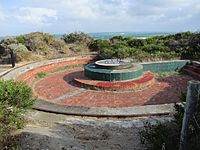
The Peron Battery, at Cape Peron, was the southernmost battery. It was set up in January 1943 with two mobile 155mm guns. It also had two 18-pounder guns, which were removed later. The main guns protected the southern entrance to Cockburn Sound. The 18-pounder guns protected a special net between Cape Peron and Garden Island. The main battery was removed in December 1944.
Challenger Battery
The Challenger Battery was built near the north-western tip of Garden Island in January 1943. It was ready by April. Like the Peron Battery, it had two mobile 155mm guns on special mounts. Its job was to protect the Challenger Passage into Cockburn Sound. It also helped the Peron Battery protect the Sound from enemy ships coming from the west. The battery was removed in December 1944.
Beacon Battery
The Beacon Battery was located east of the Challenger Battery, near the northern tip of Garden Island. It had two 4-inch naval guns and was operated by people from the Challenger Battery. This battery protected a boom net at the northern end of Cockburn Sound. It was operational from March 1943. It was put into "care and maintenance" (meaning it was looked after but not actively used) in December 1944.
Scriven Battery
The Scriven Battery, in the middle of Garden Island, was part of the pre-war defense plan but was built much later. It was meant to work with the Oliver Hill Battery, both having 9.2-inch naval guns. Unlike Oliver Hill, Scriven's construction was very slow. It started in December 1942 and wasn't finished until after World War II. Scriven Battery was supposed to help Oliver Hill provide long-range protection for Fremantle Harbour.
Oliver Hill Battery
The Oliver Hill Battery, in the center of Rottnest Island, was built in 1938. It had two 9.2-inch naval guns. Its main job was the long-range defense of Fremantle Harbour. The battery was used until October 1944, when it was shut down.
A large support system was also built on the island, and most of it is still there today. Soldiers lived at Kingstown Barracks. Supplies were brought to the battery by the Oliver Hill Railway. Several observation posts were also built.
Bickley Battery
Bickley was the second battery on Rottnest Island. It had 6-inch naval guns. Its job was the short-range defense of Fremantle Harbour, helping the Oliver Hill Battery. It was built in 1938. Fewer people worked at the battery later in the war, but one of its guns could still be used until the war ended.
Who controlled the batteries?
The control of the Fremantle Fortress batteries changed over time. In 1940, it was split into Rottnest Island and Mainland Fire Command. Rottnest Island Command was in charge during the day. Mainland Command took over the mainland batteries at night.
In late 1942, a third command, Southern Command, was added. It took charge of the Cockburn Sound batteries. The other batteries stayed under the old system. More changes happened in June 1942. Rottnest Command became Northern Command, and Mainland Command was removed. As the southern batteries closed down, Southern Command was removed in late 1944. Northern Command was then renamed Fremantle Fire Command. This last command was also removed in March 1945. Any remaining activity came under the Headquarter of Fremantle Fortress.
Who manned the batteries?
At the start of World War II, regular soldiers and militia (part-time soldiers) manned the Western Australian coastal defenses. In 1940, these units came under the Headquarter Fremantle Fixed Defences. Later in the war, more Volunteer Defence Corps members helped man the mainland batteries.
In May 1943, the engineers working at the Fremantle Fortress joined the Royal Australian Artillery. They became part of the local batteries they served at.
The Australian Women's Army Service also played a big role in defending the Australian coast. About 3,000 of its 20,000 members worked in coastal defense. Female service members also served as gunners on the coastal batteries of the Fremantle Fortress.
What were anti-submarine boom nets?
To protect Fremantle Harbour, special nets were installed across the harbor entrance in 1941. These were called anti-submarine and anti-torpedo boom nets. They stretched between North and South Moles. This barrier was a floating wire mesh net that could be opened in the middle by a winch at North Mole. Also, a special detection loop was laid between Rottnest Island and Swanbourne to detect submarines.
Protecting the anchorage at Cockburn Sound needed a huge engineering project. An almost 9.5 km long anti-submarine net was built. It stretched in an arch shape from the north-eastern end of Garden Island to Woodman Point on the mainland. This barrier took from 1942 to 1944 to build.
From Woodman Point, the barrier went west over the Parmelia Bank, a sandbank. A dredged channel, with a gate in the barrier, allowed ships through the sandbank into Cockburn Sound. From this channel, the barrier went south-west to Garden Island.
This Cockburn Sound barrier stayed until 1964. Then, the wooden poles and structures were destroyed with explosives. The steel nets were cut and dropped onto the seabed. Even so, some parts of the old barrier are still visible today. Some wooden poles still stick out of the water. Parts of the old cable have also been found at Woodman Point.
At the southern end, between Point Peron and Garden Island, a special anti-boat barrier was built. It was like a scaffolding, called a "hurdle defense." This barrier started in late 1943 and was removed shortly after the war. Its materials were reused to build farm sheds.
What happened to the fortress after the war?
The Australian government gave up the Leighton Battery site at Buckland Hill in 1984. It was given to the Town of Mosman Park. Most of the area was redeveloped, while other parts became a public park. The Royal Australian Artillery Historical Society of Western Australia was given the area where the Leighton Battery was. They now run a museum there.
In 2014, a gun shield from a ship called HMAS Adelaide was brought to Perth for repair. It had been dumped in a tip in 1943. A member of the historical society had been looking for such a shield for 20 years. They wanted it to match a 6-inch naval gun they had from HMAS Sydney. The naval gun and shield were set up at Leighton Battery in September 2015. They now look like the original 6-inch guns that were there.
The Oliver Hill Battery, its underground tunnels, and the train ride to it are popular tourist attractions on Rottnest Island. The Leighton Battery at Buckland Hill, and its underground tunnels, have been partly restored and can be visited. Tours of the underground tunnels are held on Sundays. You can also see parts of the gun mounts and observation bunker at Point Peron, which have been partly restored.
Heritage listings
The Leighton Battery site was added to the Register of the National Estate on June 22, 1993. It was recognized by the National Trust on May 13, 1996, and declared a State Register of Heritage Places on August 27, 1999. In November 2014, it received an Engineering Heritage National Marker from Engineers Australia.
The Rottnest Island part of the Fremantle Fortress also received an Engineering Heritage National Marker in November 2010. The Oliver Hill 9.2-inch battery is the last one of its kind in Australia and one of the very few remaining in the world.
Besides Leighton Battery, the Bickley and Oliver Hill Batteries on Rottnest Island, and the Peron Battery, are also listed as Western Australian State Heritage sites.
The Challenger Battery was added to the Commonwealth Heritage List on June 22, 2004.


